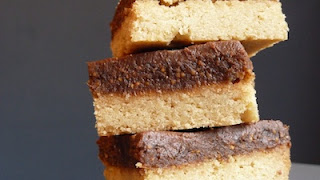Yesterday evening I made my way over to Bath for another delicious evening at Topping & Co where Richard Bertinet was coming to talk to us about Pastry. Learning from my previous experience, I arrived in good time and secured a seat in the front row with a fabulous view. Richard and sidekick Brett brought boxes and boxes of goodies and busily circulated offering freshly-baked sausage rolls (they were still warm, does that have VAT implications?) and salted caramel brownies on wooden peels. The frenzy of sharing was interrupted by the small matter of a talk and demonstration, and after a short and enthusiastic introduction, it was Richard's turn to take the floor. I think this photo shows him contemplating his recent fun and games donning his radio mike...
Richard's approach to pastry is to remove the faffing and make things easy. Don't worry about the temperature of your butter, he says. Don't chop it up, he says. Just take it in a block straight out of the fridge and, sandwiched between two papers, wallop it escalope fashion. This keeps it cool but renders it pliable and workable. Now you throw it into your flour and tear it up, then flake it between your fingers. Like breadcrumbs? Nope, just get to a point where there are no bits of butter larger than your fingernail.
Add in the liquid (in this case, eggs), work in with a scraper and finish on the worktop with your hands. If it feels like something's wrong, take your hands away - the biggest crime at this stage is overworking it. At this stage, you can optionally skate a fine layer of flour onto your worktop with a cheffy flourish before you shape your pastry before resting. Or you can just chuck flour on the front row, it's up to you. Richard passed the greaseproof-wrapped (never sweat-inducing clingfilm-wrapped!) pastry around for us to get an idea of the feel and taste of it.
Then he showed us how to make divine tartelettes using cases made from this sweet pastry. First, he showed us lemon curd meringue tartelettes, doing the cheffy business with a flamethrower and only crisping his fingers once or twice.
Mine, all mine!
He then turned to frangipane tartelettes topped with raspberry and pistachio, and glorious they were too.
I took a nibble first for the purposes of exposing the frangipane filling, honest.
Richard enjoys a glass of wine and warm applause.
Once again, it was a brilliant evening at Topping, a wonderful chance to watch an expert at work, to gain insights and inspiration, to be showered with flour, to try exquisite food. I redeemed my voucher against a copy of the book which Richard then signed, and made my way home with my head full of ideas and plans and thoughts of lemon curd.


















































